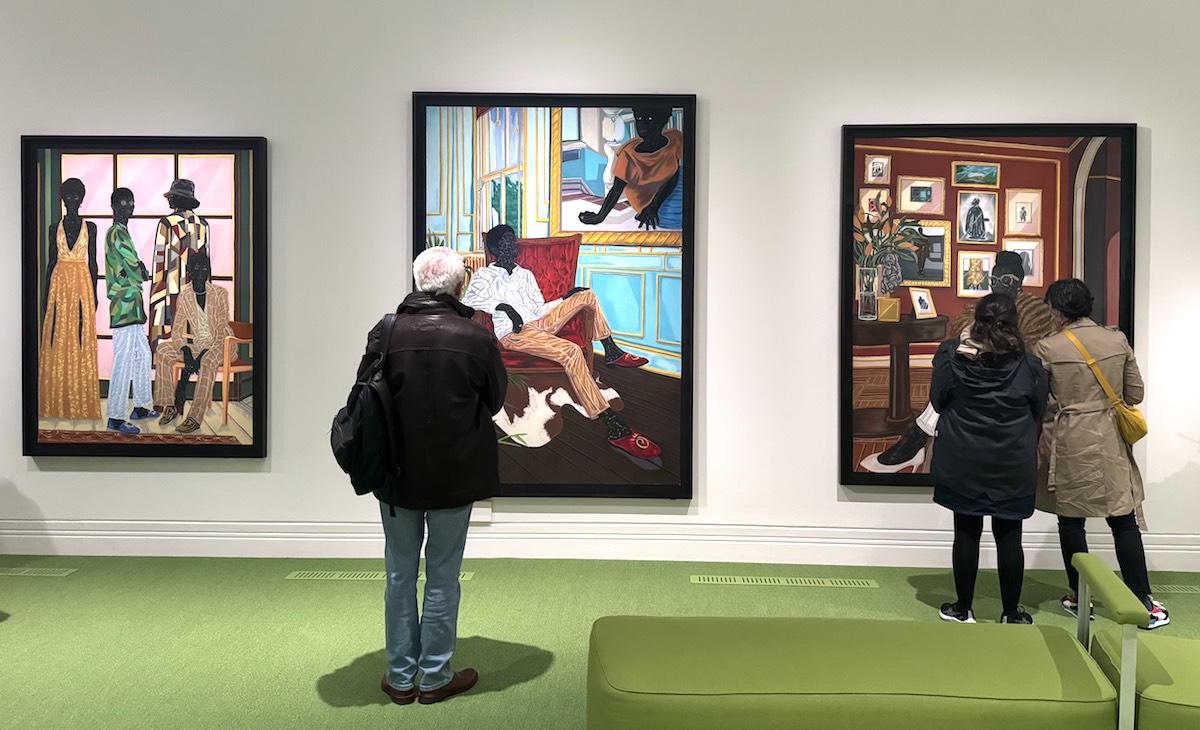Five years ago, curator and writer Ekow Eshun embarked on a mission to formulate a new narrative from the Black perspective for a 21st-century audience.
Historically, the Black figure in Western art has often been portrayed as an accessory to their European counterparts—reduced to positions of servitude and namelessness, merely fading into the background. This widespread practice of erasure and elimination of Blackness in academia is often upheld when whiteness is positioned as the apex of global human identity and Black stories are told through a white lens.

The human form is a noticeable common thread throughout the museum—modern figuration traces its evolution from antiquity to the present within the broader framework of pictorial language. His latest group exhibition, “The Time is Always Now Artists Reframe the Black Figure,” is currently showing at the National Portrait Gallery in London. Fifty-five culturally significant artworks by 22 leading contemporary artists—from the African diaspora in the UK and USA inhabit the gallery space. The wondrous assortments of works from the likes of Amy Sherald, Barbara Walker, Chris Ofili, Lubaina Himid, Njideka Akunyili Crosby, Kerry James Marshall and Michael Armitage, to name a few have been collated into three overarching themes: ‘Double Consciousness’, ‘The Persistence of History’, and ‘Our Aliveness’. Museumgoers will explore the multifaceted iterations of Black identity, culture, and societal perceptions of Black bodies conveyed through the arenas of figurative painting, drawing and sculpture.
Lorna Simpson’s large-scale cyan-green photographic works from her ‘Special Character Series’ greet you at the entrance. Thomas J Price’s newly commissioned bronze sculpture, ‘As Sounds Turn to Noise’, 2023, stationed in the connecting corridor, towers over you while you admire its luminosity and the civic disposition of a Black female subject. Simpson’s overlapping Ebony magazine imagery prompts reflection on fragmented experiences that intersect the lived Black experience. Price’s imposing sculpture transforms an everyday scene into a monumental statement—together, they powerfully assert the questions surrounding common stereotypes and what it means to be memorialised.

Claudette Johnson’s “Standing Figure with African Masks,” painted in 2018, presents a striking juxtaposition between African masks and a contemporary female sitter. The potency of the gouache and pastel background lends the work an illustrative quality. The female subject exudes confidence as she gazes directly at the viewer, her hand at her waist. She stands boldly amid the masks, with her bare stomach protruding, which creates a strong visual contrast between the African masks and the sitter’s profound connection to ancestral roots and modern art references.
Barbara Walker is concerned with the underrepresentation of black figures in public art collections. She addresses this issue through her “Vanishing Point” series, featuring delicate graphite drawings with invisible embossed images. This series illuminates the lives of historically marginalised figures, providing an alternative interpretation of history that challenges stereotypical narratives perpetuated by the art establishment.

In the final thematic exploration, ‘Our Aliveness,’ contemporary Black artists like Njideka Akunyili Crosby, Jordan Casteel, Toyin Ojih Odutola, and Henry Taylor capture intimate moments of elegance, resilience, and collective community. The room features white walls, green carpeting, and curved modular benches for the audience to sit and admire the artwork.
Though not the first of its kind, this exhibition emphasises the significance of representation and museums’ role in promoting programs and awareness of Black communities.
Historically, diaspora art has significantly increased within prominent art institutions across the capital. Exhibitions such as “Entangled Pasts, 1768–now: Art, Colonialism and Change” at the Royal Academy and “Soulscapes” at the Dulwich Picture Gallery suggest that age-old institutions that have taken an anti-racist stance are gradually opening up opportunities for Black artists as a means of attracting a more diverse audience.
Top Photo: Toyin Ojih Odutola By Albertina Campbell © Artlyst 2024
The Time is Always Now: Artists Reframe the Black Figure’, 22 February – 19 May 2024, at the National Portrait Gallery

